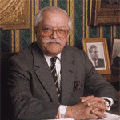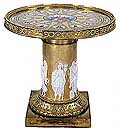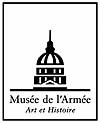| |
| |
VICTOR-ANDRE MASSENA ELECTED PRESIDENT OF THE FONDATION NAPOLEON
After eighteen years in office, the baron Gourgaud has decided to stand down as president of the Fondation Napoléon, although he will continue to serve as a trustee. As a result of his decision, he presented his resignation to the Board of Trustees on 13 December, 2005.
The Board of Trustees has elected Victor-André Masséna, Prince d'Essling, Duc de Rivoli, as president of the Fondation. The Prince became a trustee in 2002 and was elected Vice President in January 2005.
During the same meeting the Baron Gourgaud was appointed President of Honour of the Fondation Napoléon. Bernard Chevallier, chief curator of of the Musée de Malmaison et Bois-Préau was elected Vice Président.
In concert with Prince Masséna, the board of trustees thanked the Baron Gourgaud for all that he had done leading the Fondation Napoléon since 1987. Founder of the institution after the devolution of the Lapeyre bequest, he tirelessly worked to make the Fondation a place for the widest possible public, recognised for its historical competence and its activities in the preservation of Napoleonic heritage.
Press contact

|
|
|
| |
PORTRAIT OF VICTOR-ANDRE MASSENA AND HIS PROGRAMME
Born on 29 April, 1950, Victor-André Masséna qualified as a lawyer and worked at the Paris bar from 1973 to 1978. After an MBA from INSEAD, he worked initially in the export arm of Aérospatiale before moving on to other companies. Becoming manager of the DREE and commercial and economic adviser to the French embassy in Bosnia-Herzegovina, he worked to set up French aid operations during the war, notably with reference to the assistance brought to the inhabitants of Sarajevo. To read on, click here...

|
|
|
| |
THE BARON GOURGAUD'S HUGELY SUCCESSFUL PRESIDENCY
In the aftermath of the bequest made by Martial Lapeyre (d. 1984), the Baron Gourgaud, then president of the Souvenir Napoléonien, negotiated with the French state for the creation of a foundation which could become the heir to their famous benefactor. After three years' work, the Fondation Napoléon was born and was recognised as “d'utilité publique” (registered charity) by a decree of 12 November, 1987. All this happened eighteen years ago.
Quite naturally the Baron Gourgaud was appointed the first president of the Fondation and was re-elected each time thereafter. To read on, click here...

|
|
|
| |
THIS MONTH'S OBJECT
The Austerlitz or 'Maréchaux' Table
This formal piece of furniture progaganda made in memory of the famous victory at Austerlitz, the Austerlitz Table, was commissioned by Napoleon in 1806. Vivant Denon promised the emperor a «colossus in porcelain». Made over the period 1808 to 1810, this masterpiece from the Sèvres Manufactory was created by a 'dream team' of artists of the Empire period. Percier gave the general design, Gérard made that for the reliefs on the pedestal, Isabey painted the portraits for the top, and Thomire was put in charge of the bronzes. © RMN

|
|
|
| |
DON'T MISS
Only a few days left to visit the Napoleonic rooms at the Musée de l'Armée before they change for ever!
As part of the Athena project for redeveloping the museum, the exhibition halls in the East Wing (aile Orient), which house the Modern Department collection (going from Louis XIV's youth to the fall of Napoleon III) are to close on 9 January 2006 for two years (Athena III). In an attempt to meet the expectations of the museum's many visitors, an exhibition centred around the person of Napoleon is to be set up on 1 March, 2006. Furthermore, the Ancient Department, containing one of the finest collections of ancient arms and armour in the world, is to re-open to the public on 17 December, 2005 (Athena II): more than 2,000 m2 of exhibition space and a new scenography. Don't miss it!

|
|
|
| |
200 YEARS AGO
On 24 Frimaire, An XIV (15 December, 1805), an "offensive/defensive" alliance treaty was signed by France and Prussia.
On the same day (24 Frimaire (15 December)), a decree was signed at Schönbrunn creating three educational institutions for the daughters of members of the Légion d'honneur.
After the Conseil d'Etat (Council of State) had been asked to reflect upon the establishment of educational institutions for "young ladies who are children of member of the Légion", a project (of which Regnaud Saint d'Angély was the "rapporteur" or proposer), was adopted by the Conseil on 30 November, 1805. It was not before May 1806 that the Château de Chambord in the Loire region was selected as the first place to receive young ladies, the school opening at the beginning of 1807. But it was soon recognised that this chateau was not the best solution, and so the Château d'Ecouen (today the national Museum of the Renaissance and much closer to Paris) was chosen as the final solution (decree of 10 July, 1806).
The Journal de Paris of 25 Frimaire, An XIV (16 December, 1805) reported the display of particularly jibing caricatures: "Two caricatures have excited the curiosity of passers-by, making them stop in front of Monsieur Martinet's door in Rue du Coq-Saint-Honoré. The first shows Monsieur Pitt, being rocked to sleep by his supporters, dreaming that he is the puppet master who can move his marrionettes at will. In the second, John Bull (the English people) has just learnt of the success of the French Grande-Armée. In his fury, he wakes Pitt up, and as Pitt opens his eyes he sees the list of the emperor Napoleon's victories; the picture of his terror, the embarrassment of his accomplices and the disorder occasoined by the news all go to make a most comic scene, and one worthy of Calot's brush."
Wishing you an excellent, Napoleonic, week.
Peter Hicks
Historian and Web editor
THE NAPOLEON.ORG BULLETIN, No 352, 16 - 22 December, 2005
Interested in the work of the Fondation Napoléon? Why not participate, either generally or in a specific project, by making a donation.
© this Napoleon.org weekly bulletin is published by the Fondation Napoléon. Reproduction or all or part of this bulletin is forbidden, without prior agreement of the Fondation Napoléon.

|
|
|
|
|
|
|
|
THIS WEEK
RONALD ZINS NEW PRESIDENT OF THE SOUVENIR NAPOLEONIEN
On 10 december, 2005, the Directorial Committee of the Souvenir Napoléonien elected its new president, Ronald Zins, to replace the Baron de Méneval. Active delegate for the Souvenir in Lyons, Monsieur Zins is author of a biography of Marshal Lannes (Ed. Curandera, 1994) and of a series of studies on Lyons during the Empire period (Ed. Cardon).
CHRISTMAS PRESENT IDEAS!
We bring you our favourites: but you can also select your own from the "Just Published" page.
PRESS REVIEW
- French History, volume 19, no. 4, December 2005
- The limits of Napoleonic centralization: Notables and Local Government in the Department of the Isere from the Consulate to the beginning of the July Monarchy, by Marie-Cecile Thoral, p. 463
- Review article: Empire by Collaboration: The First French Colonial Empire's Rise and Demise, by Philippe R. Girard, p. 482
LIBRARY INFORMATION
During the Christmas Break, the library will be closed from 26 to 30 December, 2005.
Re-opening, Monday 2 January, 2006 with the usual hours.
For further information, click here.
WHAT'S ON
- Festival: Sixth Marie-Louise Week, Parma, Italy
- Exhibition: "Battle in a sittingroom." The Austerlitz wallpaper, Rome, Italy
- Exhibition: Napoleonica: arms, medals, prints, memorabilia of the Napoleonic period, Arezzo, Italy
- Exhibition: In the Service of Napoleon. The Dutch in time of War 1792-1815, Delft, Netherlands
- Exhibition: Napoleon on Campaign, the emperor's bivouac, at the Arc de triomphe de l'Etoile, Paris, France
- Exhibition: Napoleon: An intimate portrait, Washington, USA
- Exhibition: Napoleone e il Piemonte. Capolavori ritrovati, Alba, Italy
Got a problem with the letter? Try the home page: http://www.napoleon.org
<<
|
|




